Theoria Technical College ECE-300 Assignment on Education
VerifiedAdded on 2022/09/07
|22
|6416
|24
Homework Assignment
AI Summary
This assignment, prepared by a student, addresses key concepts in early childhood education, focusing on Developmentally Appropriate Practice (DAP), domains of learning and development, and multimodal learning styles. The student explores the importance of meeting individual child needs, fostering cognitive, emotional, and social development through play-based activities. The assignment also delves into the Early Learning Standards, highlighting engaging activities for children across different developmental domains. Furthermore, it examines the application of multimodal learning styles (visual, auditory, reading/writing, and kinesthetic) and provides practical examples to support these styles. The assignment concludes with examples of problem-solving activities, such as learning about magnets, colors, and crafting with clay, which are designed to promote children's understanding and engagement. The student references relevant literature to support the discussion and provides practical examples of how to apply these concepts in an educational setting.
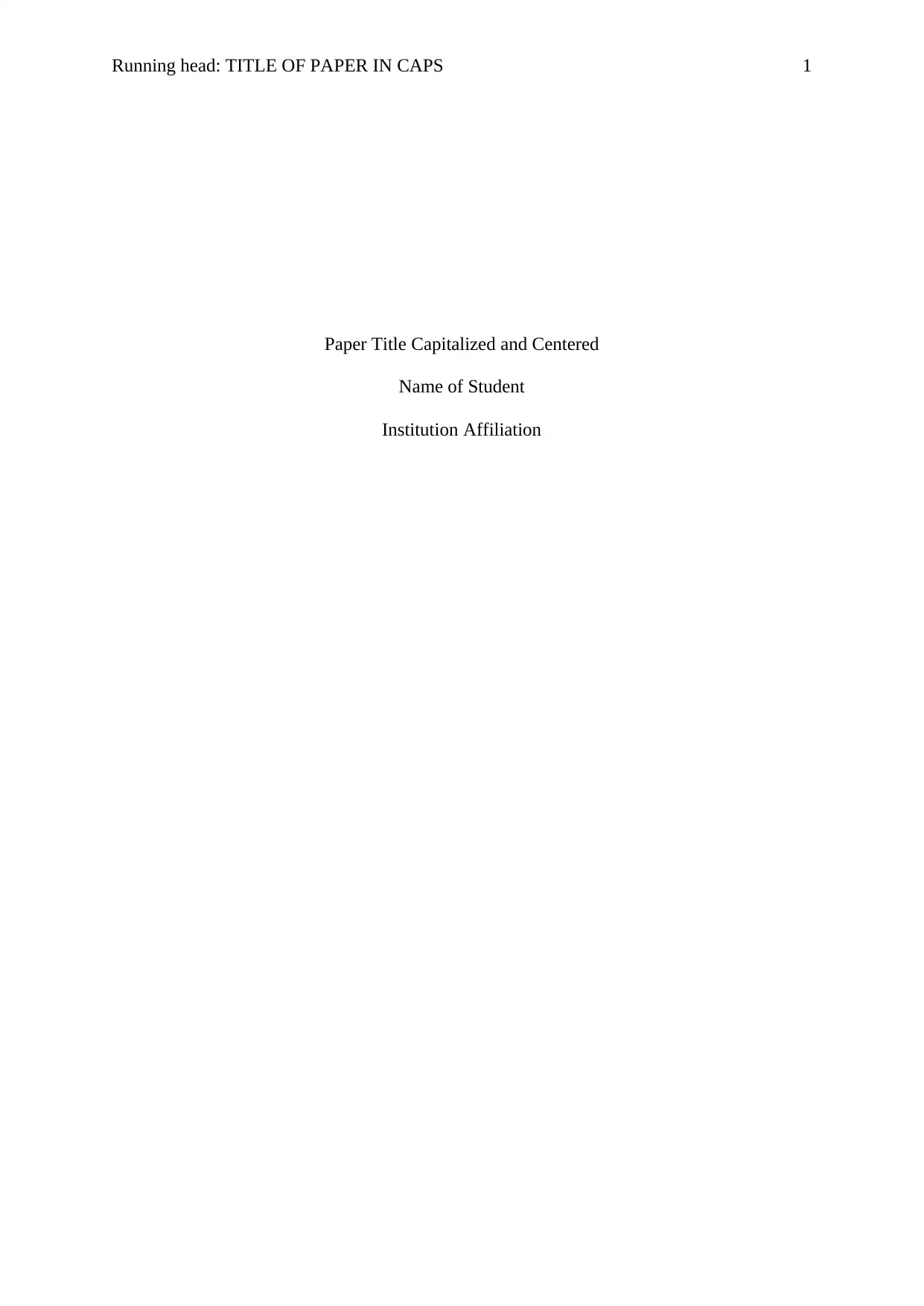
Running head: TITLE OF PAPER IN CAPS 1
Paper Title Capitalized and Centered
Name of Student
Institution Affiliation
Paper Title Capitalized and Centered
Name of Student
Institution Affiliation
Paraphrase This Document
Need a fresh take? Get an instant paraphrase of this document with our AI Paraphraser
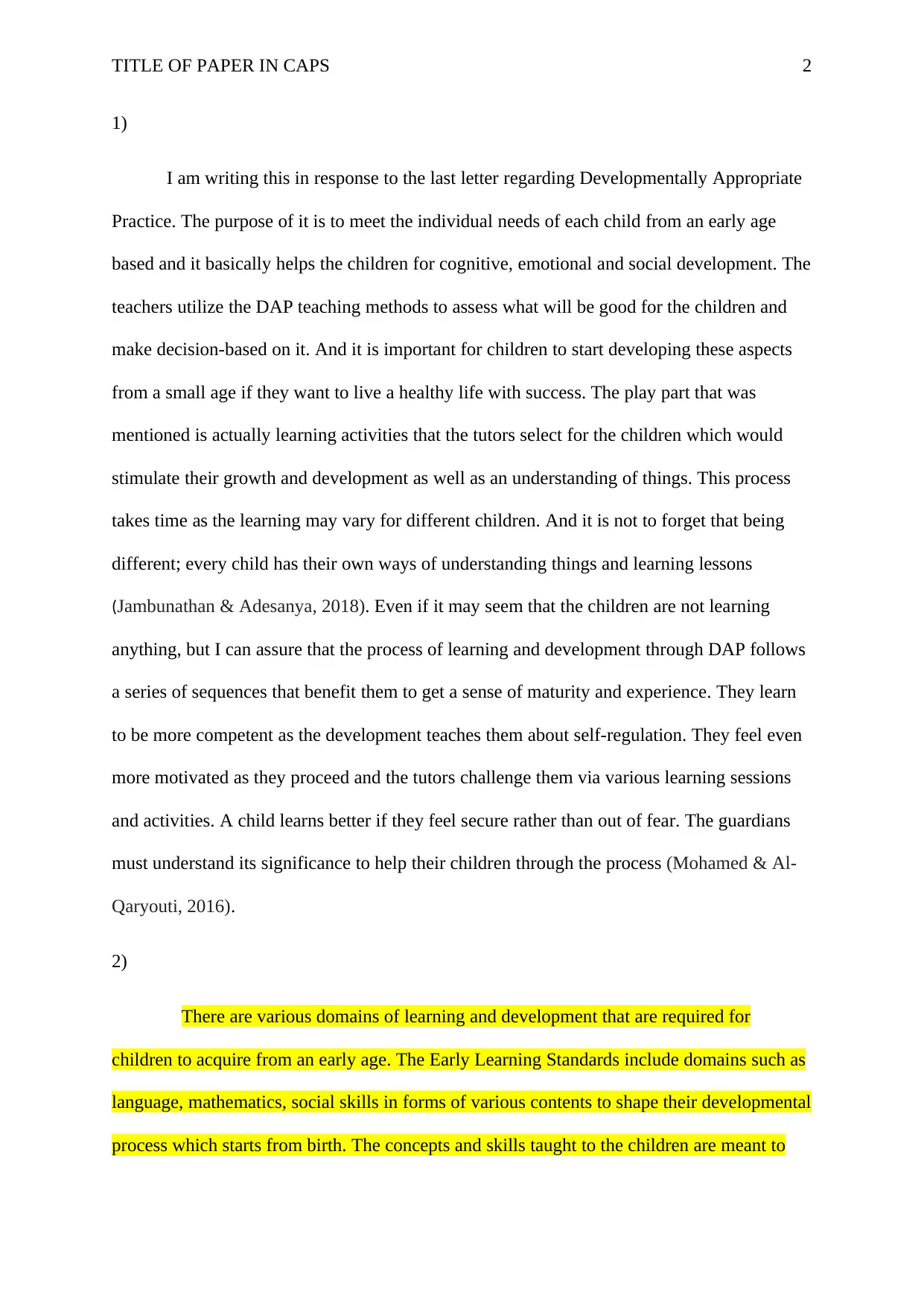
TITLE OF PAPER IN CAPS 2
1)
I am writing this in response to the last letter regarding Developmentally Appropriate
Practice. The purpose of it is to meet the individual needs of each child from an early age
based and it basically helps the children for cognitive, emotional and social development. The
teachers utilize the DAP teaching methods to assess what will be good for the children and
make decision-based on it. And it is important for children to start developing these aspects
from a small age if they want to live a healthy life with success. The play part that was
mentioned is actually learning activities that the tutors select for the children which would
stimulate their growth and development as well as an understanding of things. This process
takes time as the learning may vary for different children. And it is not to forget that being
different; every child has their own ways of understanding things and learning lessons
(Jambunathan & Adesanya, 2018). Even if it may seem that the children are not learning
anything, but I can assure that the process of learning and development through DAP follows
a series of sequences that benefit them to get a sense of maturity and experience. They learn
to be more competent as the development teaches them about self-regulation. They feel even
more motivated as they proceed and the tutors challenge them via various learning sessions
and activities. A child learns better if they feel secure rather than out of fear. The guardians
must understand its significance to help their children through the process (Mohamed & Al-
Qaryouti, 2016).
2)
There are various domains of learning and development that are required for
children to acquire from an early age. The Early Learning Standards include domains such as
language, mathematics, social skills in forms of various contents to shape their developmental
process which starts from birth. The concepts and skills taught to the children are meant to
1)
I am writing this in response to the last letter regarding Developmentally Appropriate
Practice. The purpose of it is to meet the individual needs of each child from an early age
based and it basically helps the children for cognitive, emotional and social development. The
teachers utilize the DAP teaching methods to assess what will be good for the children and
make decision-based on it. And it is important for children to start developing these aspects
from a small age if they want to live a healthy life with success. The play part that was
mentioned is actually learning activities that the tutors select for the children which would
stimulate their growth and development as well as an understanding of things. This process
takes time as the learning may vary for different children. And it is not to forget that being
different; every child has their own ways of understanding things and learning lessons
(Jambunathan & Adesanya, 2018). Even if it may seem that the children are not learning
anything, but I can assure that the process of learning and development through DAP follows
a series of sequences that benefit them to get a sense of maturity and experience. They learn
to be more competent as the development teaches them about self-regulation. They feel even
more motivated as they proceed and the tutors challenge them via various learning sessions
and activities. A child learns better if they feel secure rather than out of fear. The guardians
must understand its significance to help their children through the process (Mohamed & Al-
Qaryouti, 2016).
2)
There are various domains of learning and development that are required for
children to acquire from an early age. The Early Learning Standards include domains such as
language, mathematics, social skills in forms of various contents to shape their developmental
process which starts from birth. The concepts and skills taught to the children are meant to
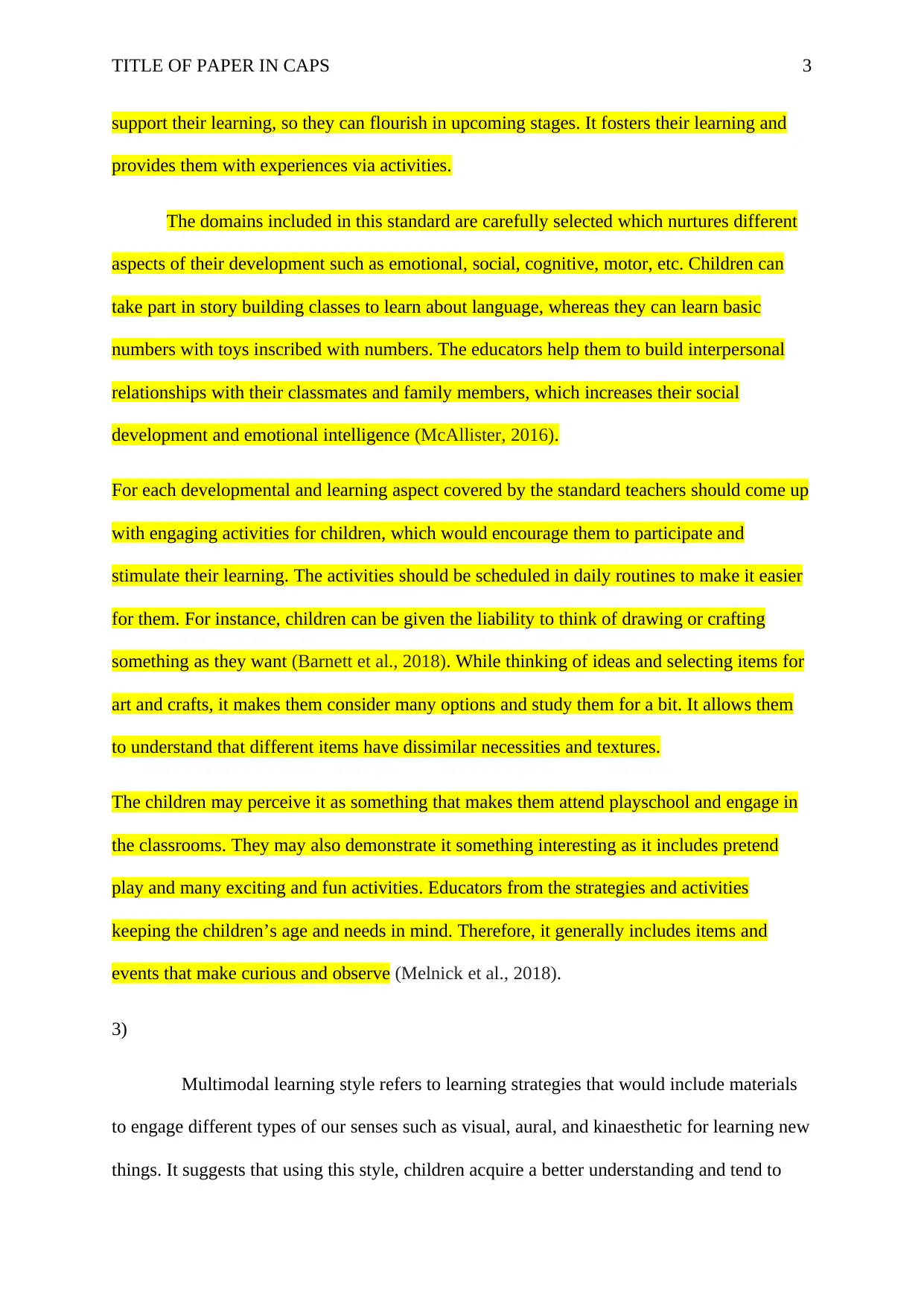
TITLE OF PAPER IN CAPS 3
support their learning, so they can flourish in upcoming stages. It fosters their learning and
provides them with experiences via activities.
The domains included in this standard are carefully selected which nurtures different
aspects of their development such as emotional, social, cognitive, motor, etc. Children can
take part in story building classes to learn about language, whereas they can learn basic
numbers with toys inscribed with numbers. The educators help them to build interpersonal
relationships with their classmates and family members, which increases their social
development and emotional intelligence (McAllister, 2016).
For each developmental and learning aspect covered by the standard teachers should come up
with engaging activities for children, which would encourage them to participate and
stimulate their learning. The activities should be scheduled in daily routines to make it easier
for them. For instance, children can be given the liability to think of drawing or crafting
something as they want (Barnett et al., 2018). While thinking of ideas and selecting items for
art and crafts, it makes them consider many options and study them for a bit. It allows them
to understand that different items have dissimilar necessities and textures.
The children may perceive it as something that makes them attend playschool and engage in
the classrooms. They may also demonstrate it something interesting as it includes pretend
play and many exciting and fun activities. Educators from the strategies and activities
keeping the children’s age and needs in mind. Therefore, it generally includes items and
events that make curious and observe (Melnick et al., 2018).
3)
Multimodal learning style refers to learning strategies that would include materials
to engage different types of our senses such as visual, aural, and kinaesthetic for learning new
things. It suggests that using this style, children acquire a better understanding and tend to
support their learning, so they can flourish in upcoming stages. It fosters their learning and
provides them with experiences via activities.
The domains included in this standard are carefully selected which nurtures different
aspects of their development such as emotional, social, cognitive, motor, etc. Children can
take part in story building classes to learn about language, whereas they can learn basic
numbers with toys inscribed with numbers. The educators help them to build interpersonal
relationships with their classmates and family members, which increases their social
development and emotional intelligence (McAllister, 2016).
For each developmental and learning aspect covered by the standard teachers should come up
with engaging activities for children, which would encourage them to participate and
stimulate their learning. The activities should be scheduled in daily routines to make it easier
for them. For instance, children can be given the liability to think of drawing or crafting
something as they want (Barnett et al., 2018). While thinking of ideas and selecting items for
art and crafts, it makes them consider many options and study them for a bit. It allows them
to understand that different items have dissimilar necessities and textures.
The children may perceive it as something that makes them attend playschool and engage in
the classrooms. They may also demonstrate it something interesting as it includes pretend
play and many exciting and fun activities. Educators from the strategies and activities
keeping the children’s age and needs in mind. Therefore, it generally includes items and
events that make curious and observe (Melnick et al., 2018).
3)
Multimodal learning style refers to learning strategies that would include materials
to engage different types of our senses such as visual, aural, and kinaesthetic for learning new
things. It suggests that using this style, children acquire a better understanding and tend to
⊘ This is a preview!⊘
Do you want full access?
Subscribe today to unlock all pages.

Trusted by 1+ million students worldwide
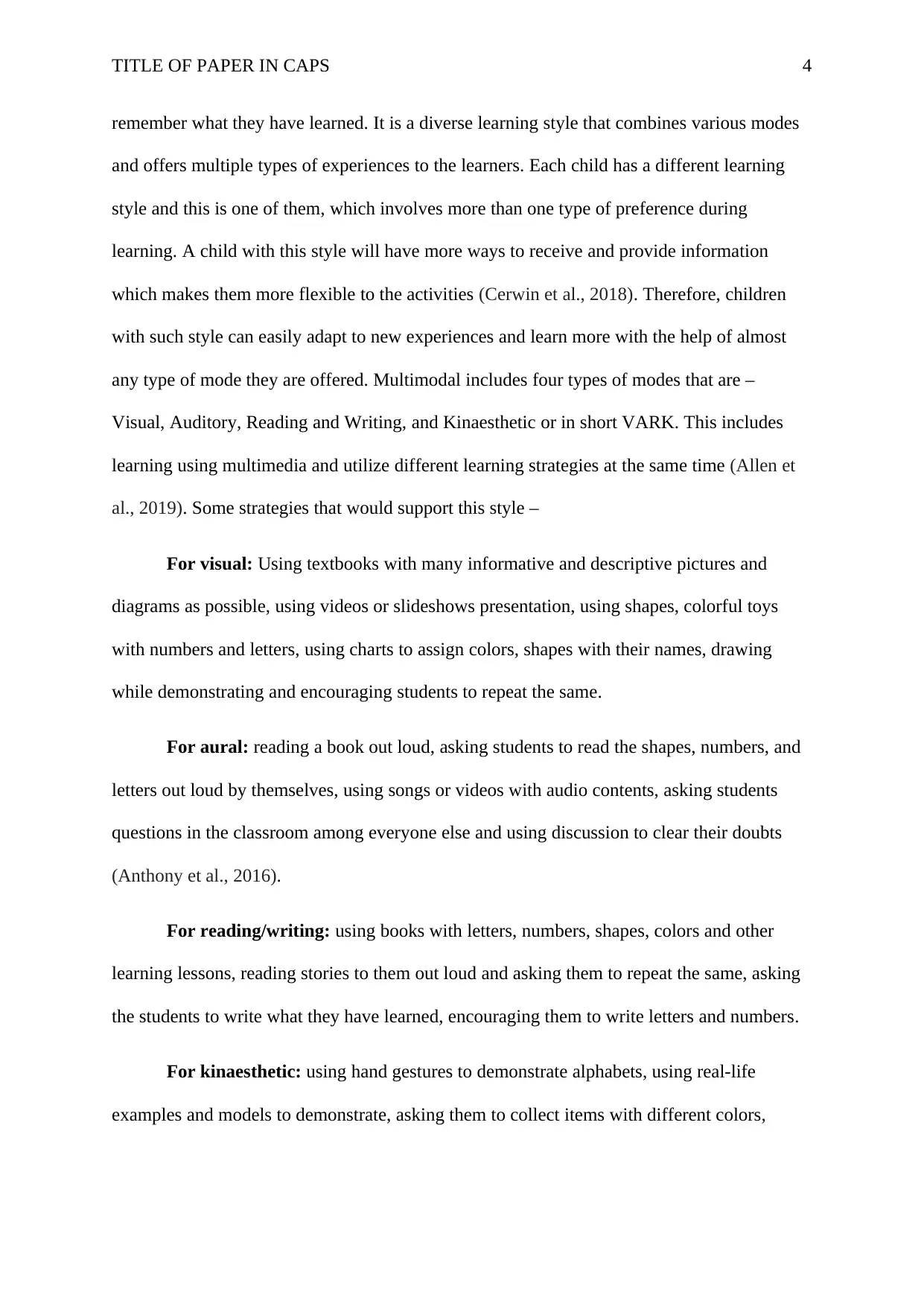
TITLE OF PAPER IN CAPS 4
remember what they have learned. It is a diverse learning style that combines various modes
and offers multiple types of experiences to the learners. Each child has a different learning
style and this is one of them, which involves more than one type of preference during
learning. A child with this style will have more ways to receive and provide information
which makes them more flexible to the activities (Cerwin et al., 2018). Therefore, children
with such style can easily adapt to new experiences and learn more with the help of almost
any type of mode they are offered. Multimodal includes four types of modes that are –
Visual, Auditory, Reading and Writing, and Kinaesthetic or in short VARK. This includes
learning using multimedia and utilize different learning strategies at the same time (Allen et
al., 2019). Some strategies that would support this style –
For visual: Using textbooks with many informative and descriptive pictures and
diagrams as possible, using videos or slideshows presentation, using shapes, colorful toys
with numbers and letters, using charts to assign colors, shapes with their names, drawing
while demonstrating and encouraging students to repeat the same.
For aural: reading a book out loud, asking students to read the shapes, numbers, and
letters out loud by themselves, using songs or videos with audio contents, asking students
questions in the classroom among everyone else and using discussion to clear their doubts
(Anthony et al., 2016).
For reading/writing: using books with letters, numbers, shapes, colors and other
learning lessons, reading stories to them out loud and asking them to repeat the same, asking
the students to write what they have learned, encouraging them to write letters and numbers.
For kinaesthetic: using hand gestures to demonstrate alphabets, using real-life
examples and models to demonstrate, asking them to collect items with different colors,
remember what they have learned. It is a diverse learning style that combines various modes
and offers multiple types of experiences to the learners. Each child has a different learning
style and this is one of them, which involves more than one type of preference during
learning. A child with this style will have more ways to receive and provide information
which makes them more flexible to the activities (Cerwin et al., 2018). Therefore, children
with such style can easily adapt to new experiences and learn more with the help of almost
any type of mode they are offered. Multimodal includes four types of modes that are –
Visual, Auditory, Reading and Writing, and Kinaesthetic or in short VARK. This includes
learning using multimedia and utilize different learning strategies at the same time (Allen et
al., 2019). Some strategies that would support this style –
For visual: Using textbooks with many informative and descriptive pictures and
diagrams as possible, using videos or slideshows presentation, using shapes, colorful toys
with numbers and letters, using charts to assign colors, shapes with their names, drawing
while demonstrating and encouraging students to repeat the same.
For aural: reading a book out loud, asking students to read the shapes, numbers, and
letters out loud by themselves, using songs or videos with audio contents, asking students
questions in the classroom among everyone else and using discussion to clear their doubts
(Anthony et al., 2016).
For reading/writing: using books with letters, numbers, shapes, colors and other
learning lessons, reading stories to them out loud and asking them to repeat the same, asking
the students to write what they have learned, encouraging them to write letters and numbers.
For kinaesthetic: using hand gestures to demonstrate alphabets, using real-life
examples and models to demonstrate, asking them to collect items with different colors,
Paraphrase This Document
Need a fresh take? Get an instant paraphrase of this document with our AI Paraphraser
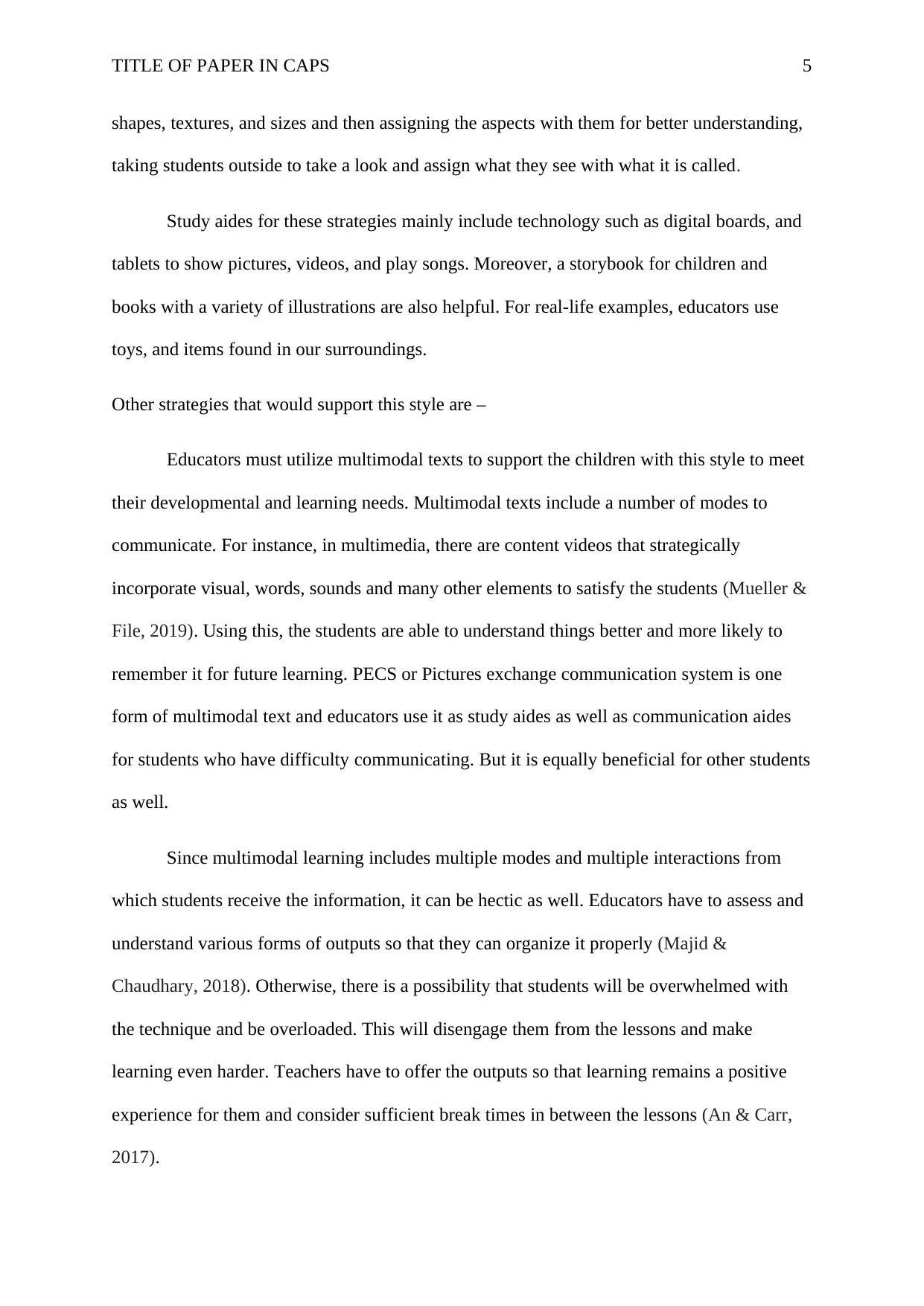
TITLE OF PAPER IN CAPS 5
shapes, textures, and sizes and then assigning the aspects with them for better understanding,
taking students outside to take a look and assign what they see with what it is called.
Study aides for these strategies mainly include technology such as digital boards, and
tablets to show pictures, videos, and play songs. Moreover, a storybook for children and
books with a variety of illustrations are also helpful. For real-life examples, educators use
toys, and items found in our surroundings.
Other strategies that would support this style are –
Educators must utilize multimodal texts to support the children with this style to meet
their developmental and learning needs. Multimodal texts include a number of modes to
communicate. For instance, in multimedia, there are content videos that strategically
incorporate visual, words, sounds and many other elements to satisfy the students (Mueller &
File, 2019). Using this, the students are able to understand things better and more likely to
remember it for future learning. PECS or Pictures exchange communication system is one
form of multimodal text and educators use it as study aides as well as communication aides
for students who have difficulty communicating. But it is equally beneficial for other students
as well.
Since multimodal learning includes multiple modes and multiple interactions from
which students receive the information, it can be hectic as well. Educators have to assess and
understand various forms of outputs so that they can organize it properly (Majid &
Chaudhary, 2018). Otherwise, there is a possibility that students will be overwhelmed with
the technique and be overloaded. This will disengage them from the lessons and make
learning even harder. Teachers have to offer the outputs so that learning remains a positive
experience for them and consider sufficient break times in between the lessons (An & Carr,
2017).
shapes, textures, and sizes and then assigning the aspects with them for better understanding,
taking students outside to take a look and assign what they see with what it is called.
Study aides for these strategies mainly include technology such as digital boards, and
tablets to show pictures, videos, and play songs. Moreover, a storybook for children and
books with a variety of illustrations are also helpful. For real-life examples, educators use
toys, and items found in our surroundings.
Other strategies that would support this style are –
Educators must utilize multimodal texts to support the children with this style to meet
their developmental and learning needs. Multimodal texts include a number of modes to
communicate. For instance, in multimedia, there are content videos that strategically
incorporate visual, words, sounds and many other elements to satisfy the students (Mueller &
File, 2019). Using this, the students are able to understand things better and more likely to
remember it for future learning. PECS or Pictures exchange communication system is one
form of multimodal text and educators use it as study aides as well as communication aides
for students who have difficulty communicating. But it is equally beneficial for other students
as well.
Since multimodal learning includes multiple modes and multiple interactions from
which students receive the information, it can be hectic as well. Educators have to assess and
understand various forms of outputs so that they can organize it properly (Majid &
Chaudhary, 2018). Otherwise, there is a possibility that students will be overwhelmed with
the technique and be overloaded. This will disengage them from the lessons and make
learning even harder. Teachers have to offer the outputs so that learning remains a positive
experience for them and consider sufficient break times in between the lessons (An & Carr,
2017).
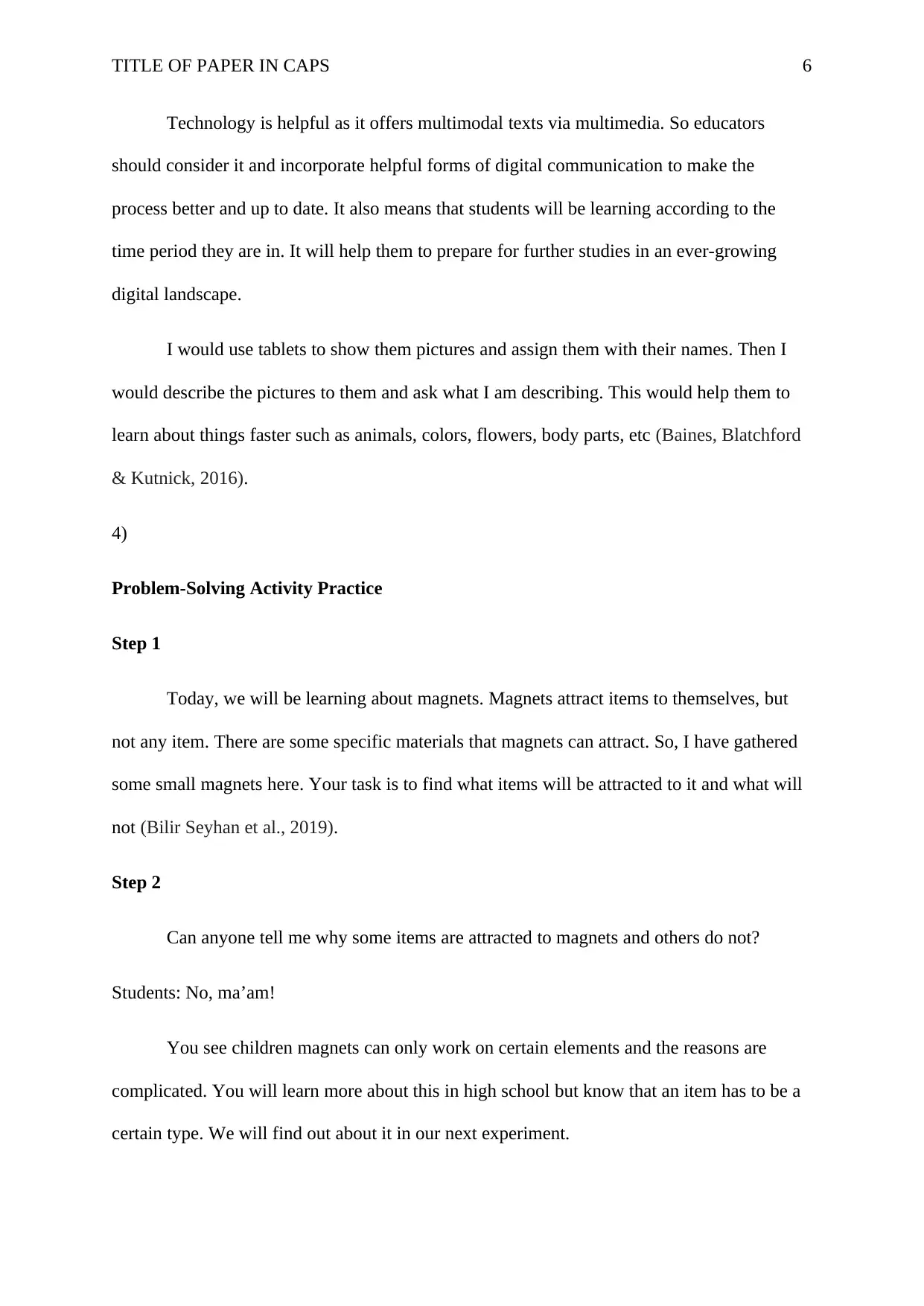
TITLE OF PAPER IN CAPS 6
Technology is helpful as it offers multimodal texts via multimedia. So educators
should consider it and incorporate helpful forms of digital communication to make the
process better and up to date. It also means that students will be learning according to the
time period they are in. It will help them to prepare for further studies in an ever-growing
digital landscape.
I would use tablets to show them pictures and assign them with their names. Then I
would describe the pictures to them and ask what I am describing. This would help them to
learn about things faster such as animals, colors, flowers, body parts, etc (Baines, Blatchford
& Kutnick, 2016).
4)
Problem-Solving Activity Practice
Step 1
Today, we will be learning about magnets. Magnets attract items to themselves, but
not any item. There are some specific materials that magnets can attract. So, I have gathered
some small magnets here. Your task is to find what items will be attracted to it and what will
not (Bilir Seyhan et al., 2019).
Step 2
Can anyone tell me why some items are attracted to magnets and others do not?
Students: No, ma’am!
You see children magnets can only work on certain elements and the reasons are
complicated. You will learn more about this in high school but know that an item has to be a
certain type. We will find out about it in our next experiment.
Technology is helpful as it offers multimodal texts via multimedia. So educators
should consider it and incorporate helpful forms of digital communication to make the
process better and up to date. It also means that students will be learning according to the
time period they are in. It will help them to prepare for further studies in an ever-growing
digital landscape.
I would use tablets to show them pictures and assign them with their names. Then I
would describe the pictures to them and ask what I am describing. This would help them to
learn about things faster such as animals, colors, flowers, body parts, etc (Baines, Blatchford
& Kutnick, 2016).
4)
Problem-Solving Activity Practice
Step 1
Today, we will be learning about magnets. Magnets attract items to themselves, but
not any item. There are some specific materials that magnets can attract. So, I have gathered
some small magnets here. Your task is to find what items will be attracted to it and what will
not (Bilir Seyhan et al., 2019).
Step 2
Can anyone tell me why some items are attracted to magnets and others do not?
Students: No, ma’am!
You see children magnets can only work on certain elements and the reasons are
complicated. You will learn more about this in high school but know that an item has to be a
certain type. We will find out about it in our next experiment.
⊘ This is a preview!⊘
Do you want full access?
Subscribe today to unlock all pages.

Trusted by 1+ million students worldwide
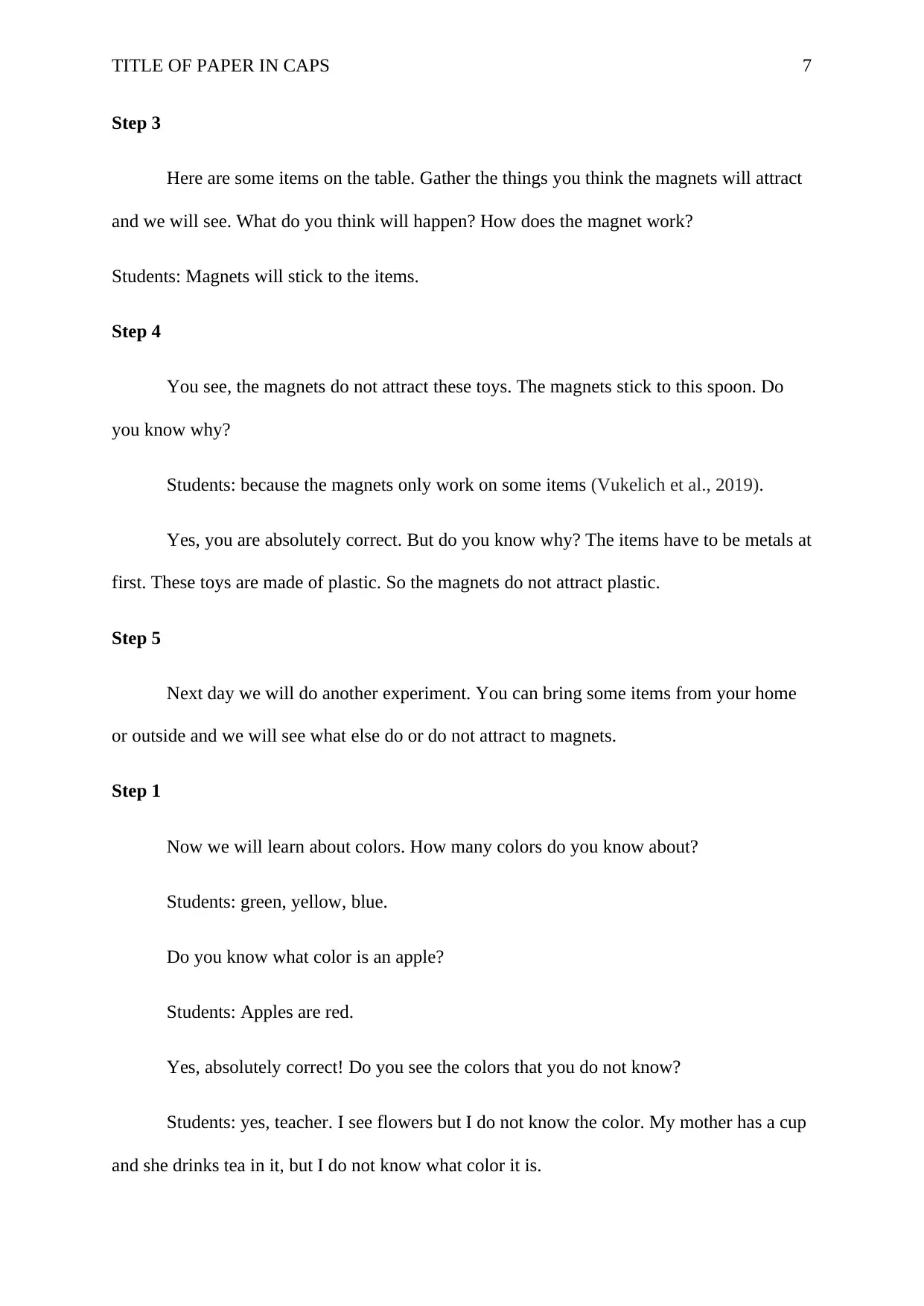
TITLE OF PAPER IN CAPS 7
Step 3
Here are some items on the table. Gather the things you think the magnets will attract
and we will see. What do you think will happen? How does the magnet work?
Students: Magnets will stick to the items.
Step 4
You see, the magnets do not attract these toys. The magnets stick to this spoon. Do
you know why?
Students: because the magnets only work on some items (Vukelich et al., 2019).
Yes, you are absolutely correct. But do you know why? The items have to be metals at
first. These toys are made of plastic. So the magnets do not attract plastic.
Step 5
Next day we will do another experiment. You can bring some items from your home
or outside and we will see what else do or do not attract to magnets.
Step 1
Now we will learn about colors. How many colors do you know about?
Students: green, yellow, blue.
Do you know what color is an apple?
Students: Apples are red.
Yes, absolutely correct! Do you see the colors that you do not know?
Students: yes, teacher. I see flowers but I do not know the color. My mother has a cup
and she drinks tea in it, but I do not know what color it is.
Step 3
Here are some items on the table. Gather the things you think the magnets will attract
and we will see. What do you think will happen? How does the magnet work?
Students: Magnets will stick to the items.
Step 4
You see, the magnets do not attract these toys. The magnets stick to this spoon. Do
you know why?
Students: because the magnets only work on some items (Vukelich et al., 2019).
Yes, you are absolutely correct. But do you know why? The items have to be metals at
first. These toys are made of plastic. So the magnets do not attract plastic.
Step 5
Next day we will do another experiment. You can bring some items from your home
or outside and we will see what else do or do not attract to magnets.
Step 1
Now we will learn about colors. How many colors do you know about?
Students: green, yellow, blue.
Do you know what color is an apple?
Students: Apples are red.
Yes, absolutely correct! Do you see the colors that you do not know?
Students: yes, teacher. I see flowers but I do not know the color. My mother has a cup
and she drinks tea in it, but I do not know what color it is.
Paraphrase This Document
Need a fresh take? Get an instant paraphrase of this document with our AI Paraphraser
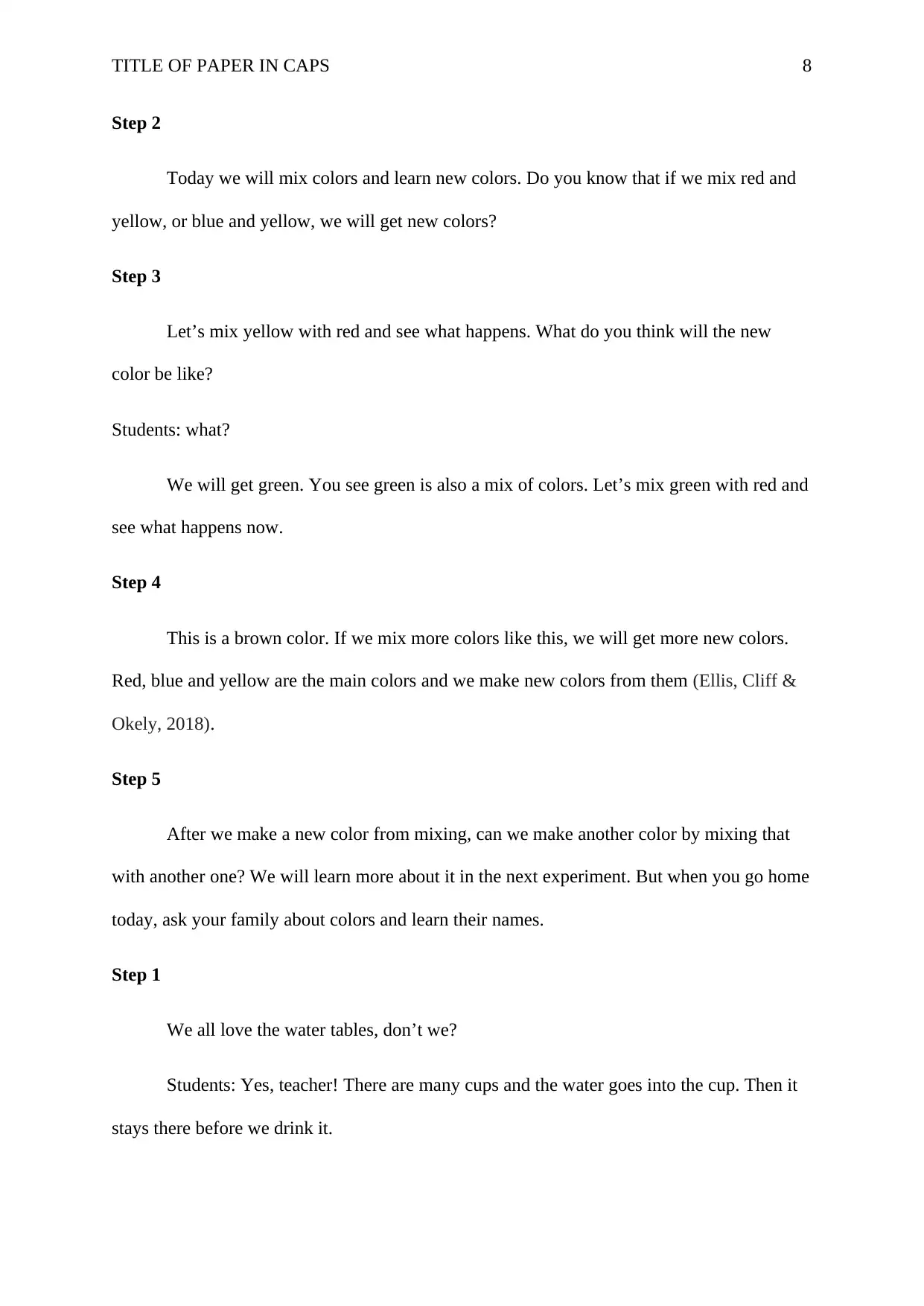
TITLE OF PAPER IN CAPS 8
Step 2
Today we will mix colors and learn new colors. Do you know that if we mix red and
yellow, or blue and yellow, we will get new colors?
Step 3
Let’s mix yellow with red and see what happens. What do you think will the new
color be like?
Students: what?
We will get green. You see green is also a mix of colors. Let’s mix green with red and
see what happens now.
Step 4
This is a brown color. If we mix more colors like this, we will get more new colors.
Red, blue and yellow are the main colors and we make new colors from them (Ellis, Cliff &
Okely, 2018).
Step 5
After we make a new color from mixing, can we make another color by mixing that
with another one? We will learn more about it in the next experiment. But when you go home
today, ask your family about colors and learn their names.
Step 1
We all love the water tables, don’t we?
Students: Yes, teacher! There are many cups and the water goes into the cup. Then it
stays there before we drink it.
Step 2
Today we will mix colors and learn new colors. Do you know that if we mix red and
yellow, or blue and yellow, we will get new colors?
Step 3
Let’s mix yellow with red and see what happens. What do you think will the new
color be like?
Students: what?
We will get green. You see green is also a mix of colors. Let’s mix green with red and
see what happens now.
Step 4
This is a brown color. If we mix more colors like this, we will get more new colors.
Red, blue and yellow are the main colors and we make new colors from them (Ellis, Cliff &
Okely, 2018).
Step 5
After we make a new color from mixing, can we make another color by mixing that
with another one? We will learn more about it in the next experiment. But when you go home
today, ask your family about colors and learn their names.
Step 1
We all love the water tables, don’t we?
Students: Yes, teacher! There are many cups and the water goes into the cup. Then it
stays there before we drink it.
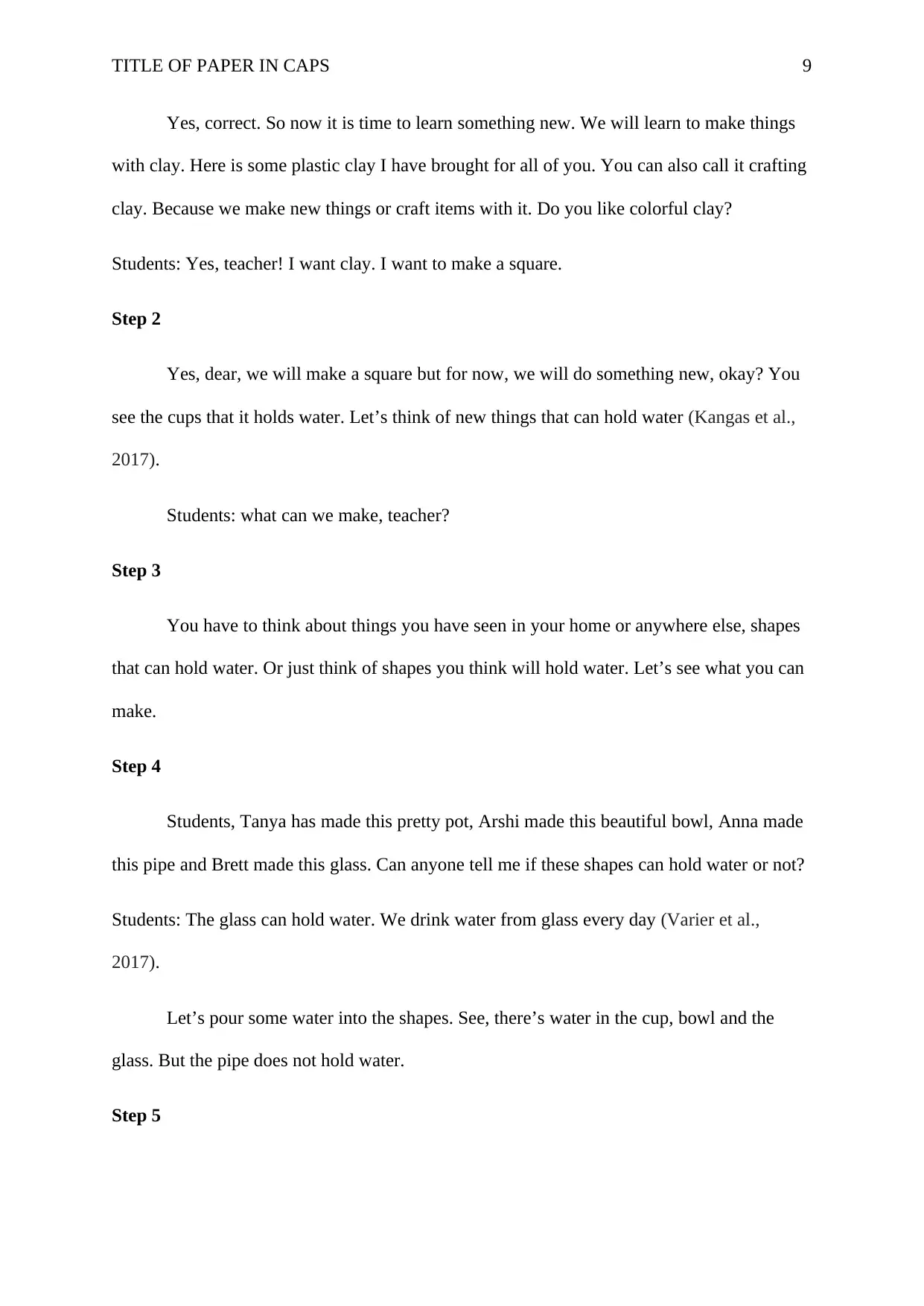
TITLE OF PAPER IN CAPS 9
Yes, correct. So now it is time to learn something new. We will learn to make things
with clay. Here is some plastic clay I have brought for all of you. You can also call it crafting
clay. Because we make new things or craft items with it. Do you like colorful clay?
Students: Yes, teacher! I want clay. I want to make a square.
Step 2
Yes, dear, we will make a square but for now, we will do something new, okay? You
see the cups that it holds water. Let’s think of new things that can hold water (Kangas et al.,
2017).
Students: what can we make, teacher?
Step 3
You have to think about things you have seen in your home or anywhere else, shapes
that can hold water. Or just think of shapes you think will hold water. Let’s see what you can
make.
Step 4
Students, Tanya has made this pretty pot, Arshi made this beautiful bowl, Anna made
this pipe and Brett made this glass. Can anyone tell me if these shapes can hold water or not?
Students: The glass can hold water. We drink water from glass every day (Varier et al.,
2017).
Let’s pour some water into the shapes. See, there’s water in the cup, bowl and the
glass. But the pipe does not hold water.
Step 5
Yes, correct. So now it is time to learn something new. We will learn to make things
with clay. Here is some plastic clay I have brought for all of you. You can also call it crafting
clay. Because we make new things or craft items with it. Do you like colorful clay?
Students: Yes, teacher! I want clay. I want to make a square.
Step 2
Yes, dear, we will make a square but for now, we will do something new, okay? You
see the cups that it holds water. Let’s think of new things that can hold water (Kangas et al.,
2017).
Students: what can we make, teacher?
Step 3
You have to think about things you have seen in your home or anywhere else, shapes
that can hold water. Or just think of shapes you think will hold water. Let’s see what you can
make.
Step 4
Students, Tanya has made this pretty pot, Arshi made this beautiful bowl, Anna made
this pipe and Brett made this glass. Can anyone tell me if these shapes can hold water or not?
Students: The glass can hold water. We drink water from glass every day (Varier et al.,
2017).
Let’s pour some water into the shapes. See, there’s water in the cup, bowl and the
glass. But the pipe does not hold water.
Step 5
⊘ This is a preview!⊘
Do you want full access?
Subscribe today to unlock all pages.

Trusted by 1+ million students worldwide
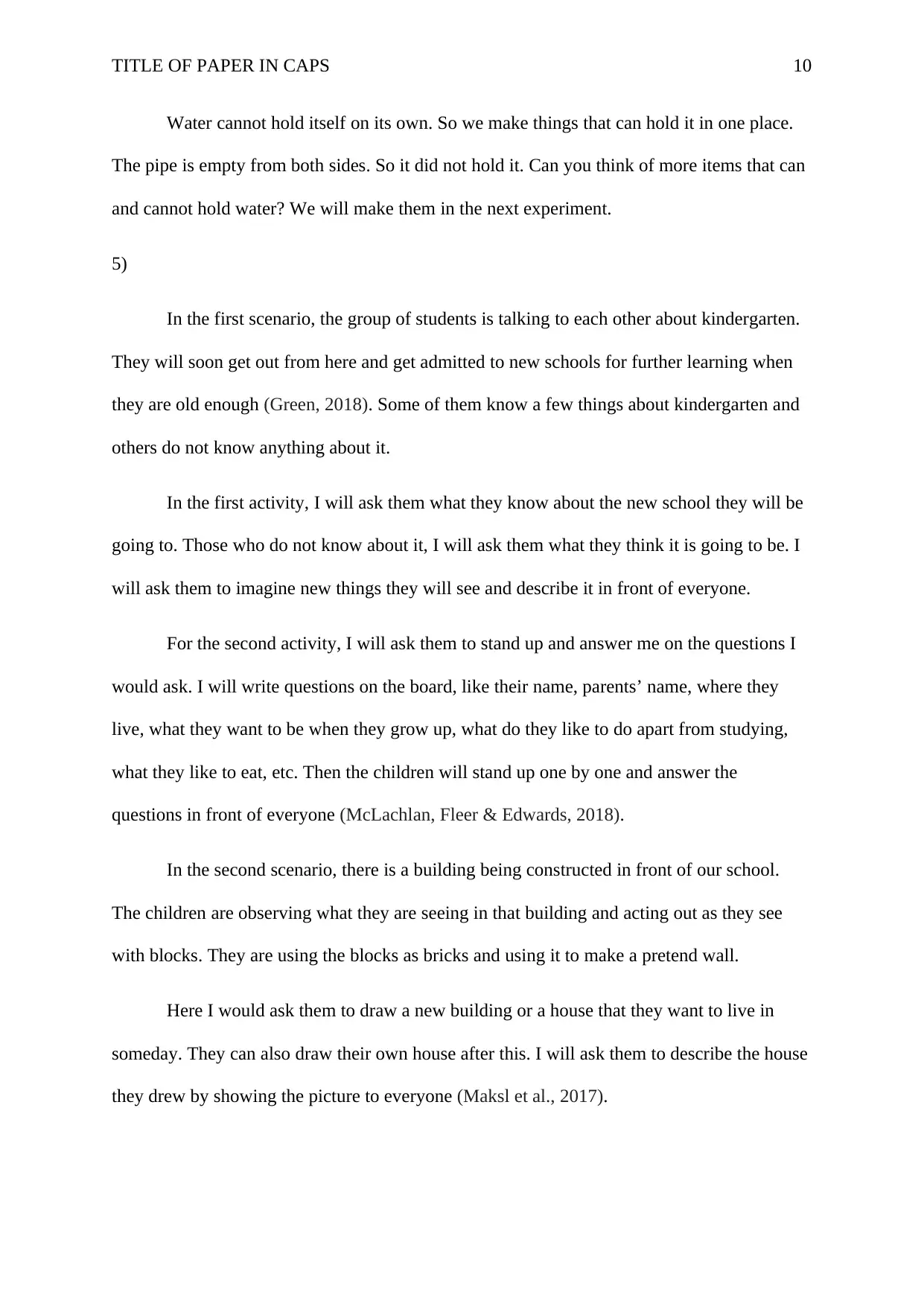
TITLE OF PAPER IN CAPS 10
Water cannot hold itself on its own. So we make things that can hold it in one place.
The pipe is empty from both sides. So it did not hold it. Can you think of more items that can
and cannot hold water? We will make them in the next experiment.
5)
In the first scenario, the group of students is talking to each other about kindergarten.
They will soon get out from here and get admitted to new schools for further learning when
they are old enough (Green, 2018). Some of them know a few things about kindergarten and
others do not know anything about it.
In the first activity, I will ask them what they know about the new school they will be
going to. Those who do not know about it, I will ask them what they think it is going to be. I
will ask them to imagine new things they will see and describe it in front of everyone.
For the second activity, I will ask them to stand up and answer me on the questions I
would ask. I will write questions on the board, like their name, parents’ name, where they
live, what they want to be when they grow up, what do they like to do apart from studying,
what they like to eat, etc. Then the children will stand up one by one and answer the
questions in front of everyone (McLachlan, Fleer & Edwards, 2018).
In the second scenario, there is a building being constructed in front of our school.
The children are observing what they are seeing in that building and acting out as they see
with blocks. They are using the blocks as bricks and using it to make a pretend wall.
Here I would ask them to draw a new building or a house that they want to live in
someday. They can also draw their own house after this. I will ask them to describe the house
they drew by showing the picture to everyone (Maksl et al., 2017).
Water cannot hold itself on its own. So we make things that can hold it in one place.
The pipe is empty from both sides. So it did not hold it. Can you think of more items that can
and cannot hold water? We will make them in the next experiment.
5)
In the first scenario, the group of students is talking to each other about kindergarten.
They will soon get out from here and get admitted to new schools for further learning when
they are old enough (Green, 2018). Some of them know a few things about kindergarten and
others do not know anything about it.
In the first activity, I will ask them what they know about the new school they will be
going to. Those who do not know about it, I will ask them what they think it is going to be. I
will ask them to imagine new things they will see and describe it in front of everyone.
For the second activity, I will ask them to stand up and answer me on the questions I
would ask. I will write questions on the board, like their name, parents’ name, where they
live, what they want to be when they grow up, what do they like to do apart from studying,
what they like to eat, etc. Then the children will stand up one by one and answer the
questions in front of everyone (McLachlan, Fleer & Edwards, 2018).
In the second scenario, there is a building being constructed in front of our school.
The children are observing what they are seeing in that building and acting out as they see
with blocks. They are using the blocks as bricks and using it to make a pretend wall.
Here I would ask them to draw a new building or a house that they want to live in
someday. They can also draw their own house after this. I will ask them to describe the house
they drew by showing the picture to everyone (Maksl et al., 2017).
Paraphrase This Document
Need a fresh take? Get an instant paraphrase of this document with our AI Paraphraser
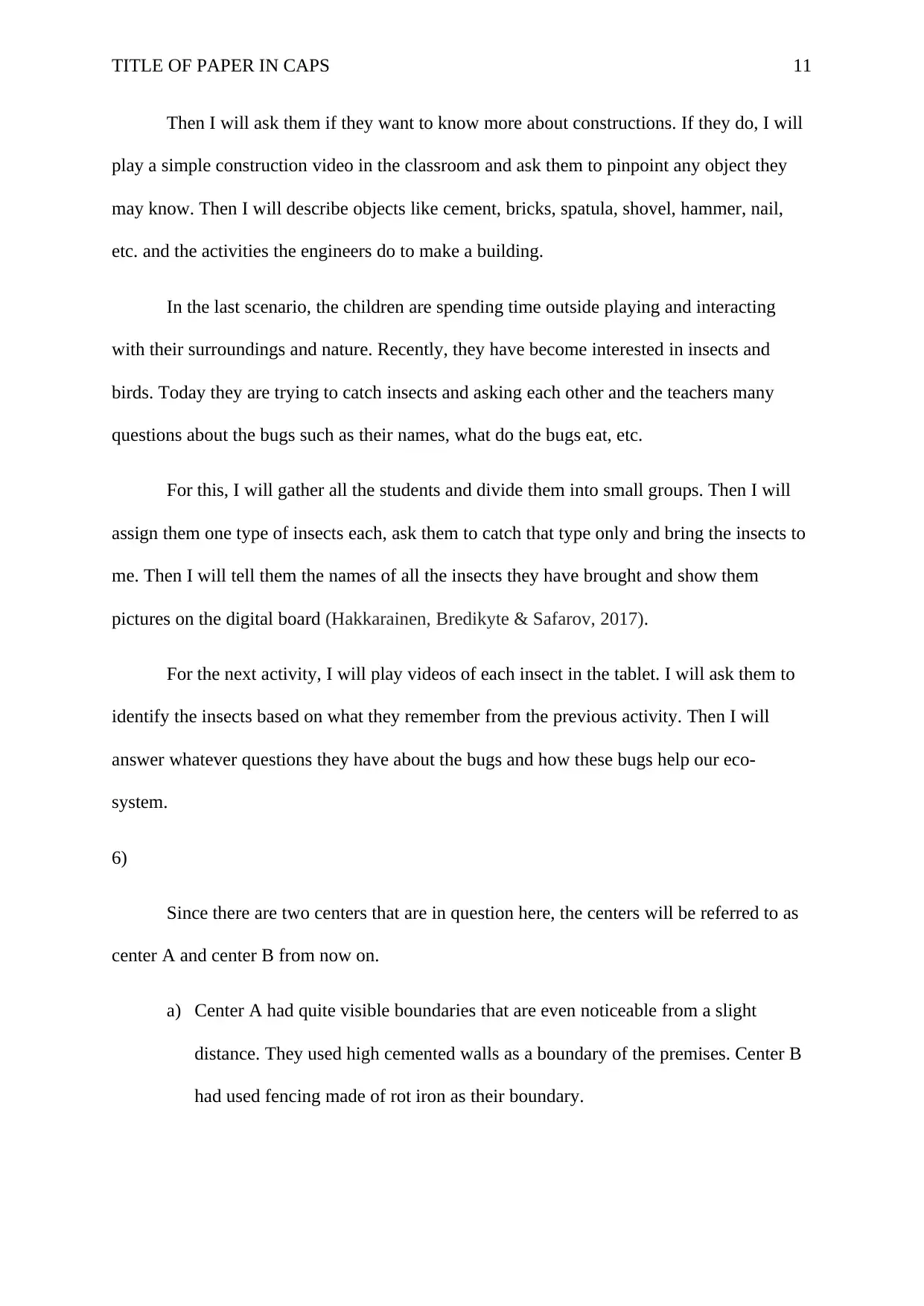
TITLE OF PAPER IN CAPS 11
Then I will ask them if they want to know more about constructions. If they do, I will
play a simple construction video in the classroom and ask them to pinpoint any object they
may know. Then I will describe objects like cement, bricks, spatula, shovel, hammer, nail,
etc. and the activities the engineers do to make a building.
In the last scenario, the children are spending time outside playing and interacting
with their surroundings and nature. Recently, they have become interested in insects and
birds. Today they are trying to catch insects and asking each other and the teachers many
questions about the bugs such as their names, what do the bugs eat, etc.
For this, I will gather all the students and divide them into small groups. Then I will
assign them one type of insects each, ask them to catch that type only and bring the insects to
me. Then I will tell them the names of all the insects they have brought and show them
pictures on the digital board (Hakkarainen, Bredikyte & Safarov, 2017).
For the next activity, I will play videos of each insect in the tablet. I will ask them to
identify the insects based on what they remember from the previous activity. Then I will
answer whatever questions they have about the bugs and how these bugs help our eco-
system.
6)
Since there are two centers that are in question here, the centers will be referred to as
center A and center B from now on.
a) Center A had quite visible boundaries that are even noticeable from a slight
distance. They used high cemented walls as a boundary of the premises. Center B
had used fencing made of rot iron as their boundary.
Then I will ask them if they want to know more about constructions. If they do, I will
play a simple construction video in the classroom and ask them to pinpoint any object they
may know. Then I will describe objects like cement, bricks, spatula, shovel, hammer, nail,
etc. and the activities the engineers do to make a building.
In the last scenario, the children are spending time outside playing and interacting
with their surroundings and nature. Recently, they have become interested in insects and
birds. Today they are trying to catch insects and asking each other and the teachers many
questions about the bugs such as their names, what do the bugs eat, etc.
For this, I will gather all the students and divide them into small groups. Then I will
assign them one type of insects each, ask them to catch that type only and bring the insects to
me. Then I will tell them the names of all the insects they have brought and show them
pictures on the digital board (Hakkarainen, Bredikyte & Safarov, 2017).
For the next activity, I will play videos of each insect in the tablet. I will ask them to
identify the insects based on what they remember from the previous activity. Then I will
answer whatever questions they have about the bugs and how these bugs help our eco-
system.
6)
Since there are two centers that are in question here, the centers will be referred to as
center A and center B from now on.
a) Center A had quite visible boundaries that are even noticeable from a slight
distance. They used high cemented walls as a boundary of the premises. Center B
had used fencing made of rot iron as their boundary.
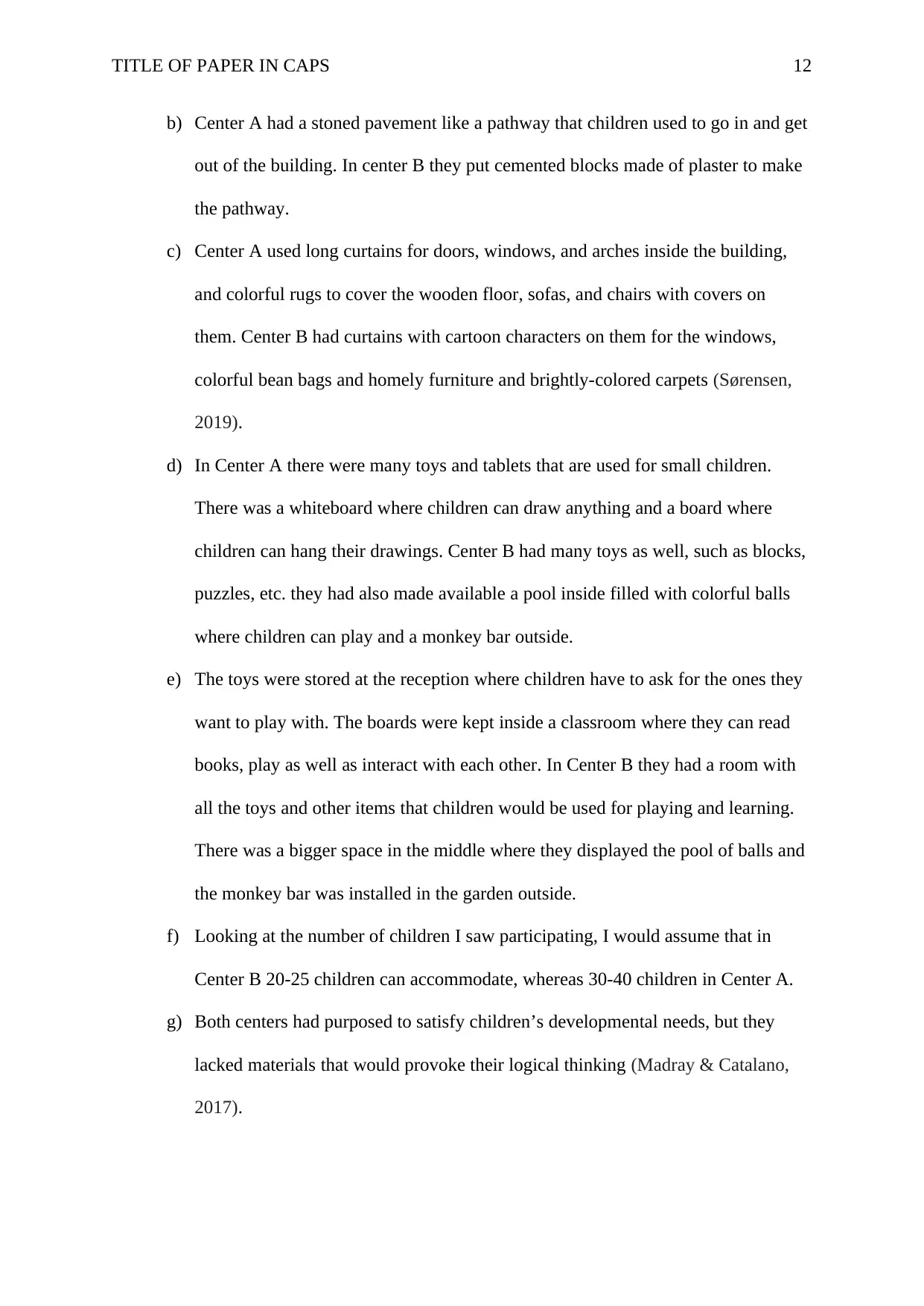
TITLE OF PAPER IN CAPS 12
b) Center A had a stoned pavement like a pathway that children used to go in and get
out of the building. In center B they put cemented blocks made of plaster to make
the pathway.
c) Center A used long curtains for doors, windows, and arches inside the building,
and colorful rugs to cover the wooden floor, sofas, and chairs with covers on
them. Center B had curtains with cartoon characters on them for the windows,
colorful bean bags and homely furniture and brightly-colored carpets (Sørensen,
2019).
d) In Center A there were many toys and tablets that are used for small children.
There was a whiteboard where children can draw anything and a board where
children can hang their drawings. Center B had many toys as well, such as blocks,
puzzles, etc. they had also made available a pool inside filled with colorful balls
where children can play and a monkey bar outside.
e) The toys were stored at the reception where children have to ask for the ones they
want to play with. The boards were kept inside a classroom where they can read
books, play as well as interact with each other. In Center B they had a room with
all the toys and other items that children would be used for playing and learning.
There was a bigger space in the middle where they displayed the pool of balls and
the monkey bar was installed in the garden outside.
f) Looking at the number of children I saw participating, I would assume that in
Center B 20-25 children can accommodate, whereas 30-40 children in Center A.
g) Both centers had purposed to satisfy children’s developmental needs, but they
lacked materials that would provoke their logical thinking (Madray & Catalano,
2017).
b) Center A had a stoned pavement like a pathway that children used to go in and get
out of the building. In center B they put cemented blocks made of plaster to make
the pathway.
c) Center A used long curtains for doors, windows, and arches inside the building,
and colorful rugs to cover the wooden floor, sofas, and chairs with covers on
them. Center B had curtains with cartoon characters on them for the windows,
colorful bean bags and homely furniture and brightly-colored carpets (Sørensen,
2019).
d) In Center A there were many toys and tablets that are used for small children.
There was a whiteboard where children can draw anything and a board where
children can hang their drawings. Center B had many toys as well, such as blocks,
puzzles, etc. they had also made available a pool inside filled with colorful balls
where children can play and a monkey bar outside.
e) The toys were stored at the reception where children have to ask for the ones they
want to play with. The boards were kept inside a classroom where they can read
books, play as well as interact with each other. In Center B they had a room with
all the toys and other items that children would be used for playing and learning.
There was a bigger space in the middle where they displayed the pool of balls and
the monkey bar was installed in the garden outside.
f) Looking at the number of children I saw participating, I would assume that in
Center B 20-25 children can accommodate, whereas 30-40 children in Center A.
g) Both centers had purposed to satisfy children’s developmental needs, but they
lacked materials that would provoke their logical thinking (Madray & Catalano,
2017).
⊘ This is a preview!⊘
Do you want full access?
Subscribe today to unlock all pages.

Trusted by 1+ million students worldwide
1 out of 22
Related Documents
Your All-in-One AI-Powered Toolkit for Academic Success.
+13062052269
info@desklib.com
Available 24*7 on WhatsApp / Email
![[object Object]](/_next/static/media/star-bottom.7253800d.svg)
Unlock your academic potential
Copyright © 2020–2025 A2Z Services. All Rights Reserved. Developed and managed by ZUCOL.





